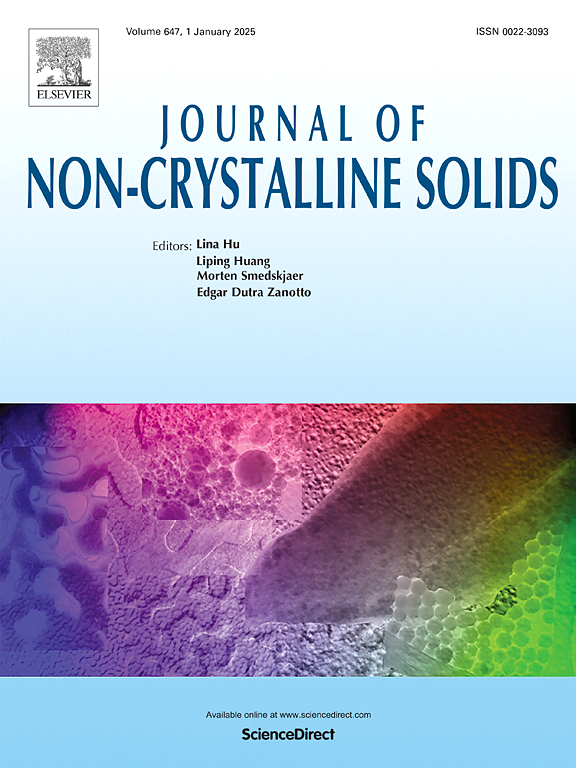Refining nanocrystalline-amorphous composite structure for superior soft magnetics in FeBSiPMoCu alloys via localized dynamic high-entropy effect enhanced by Mo micro-alloying
IF 3.5
3区 材料科学
Q1 MATERIALS SCIENCE, CERAMICS
引用次数: 0
Abstract
The amorphous formability (AFA), thermal stability, microstructure and soft-magnetism of Fe83-xB8Si4P4MoxCu1 (x = 0–4) alloys were systematically investigated, and the mechanism of Mo micro-alloying induced grain refinement was discussed. It is found that the Mo alloying can effectively enhance the AFA and soft-magnetism, as well as enlarge the heat treatment parameter window. Superior soft magnetism containing high Bs of 1.48–1.76 T, low Hc of 6.7–11.4 A/m and high μe of 1.57–2.21 × 104 was obtained by annealing for 10 min in a common vacuum furnace. The α-Fe(Si) grains in the nanocrystalline-amorphous composite structure were refined from 27 nm to 17 nm, due to the slow diffusion rate for grain growth and stabilized amorphous matrix composed with Fe, B, P and Mo. The enrichment of amorphous forming elements can introduce localized dynamic high-entropy effect during the structure evolution, which is beneficial for the fine structure in multi-component alloys. These Mo-containing alloys with attractive magnetism and processability should be promising candidates for scale production and electromagnetic applications.
通过Mo微合金化增强局部动态高熵效应,细化FeBSiPMoCu合金的纳米晶-非晶复合结构,使其具有优异的软磁性能
系统研究了Fe83-xB8Si4P4MoxCu1 (x = 0-4)合金的非晶态成形性能、热稳定性、显微组织和软磁性能,探讨了Mo微合金化诱导晶粒细化的机理。结果表明,Mo合金化能有效提高合金的AFA和软磁性,并扩大热处理参数窗口。在普通真空炉中退火10 min,可获得高Bs为1.48 ~ 1.76 T,低Hc为6.7 ~ 11.4 A/m,高μe为1.57 ~ 2.21 × 104的优异软磁材料。纳米晶-非晶复合结构中的α-Fe(Si)晶粒由27 nm细化到17 nm,主要是由于晶粒生长的扩散速率缓慢和由Fe、B、P和Mo组成的稳定的非晶基体。非晶形成元素的富集在组织演化过程中引入局部动态高熵效应,有利于多组分合金的细化组织。这些含钼合金具有吸引人的磁性和可加工性,应该是大规模生产和电磁应用的有希望的候选者。
本文章由计算机程序翻译,如有差异,请以英文原文为准。
求助全文
约1分钟内获得全文
求助全文
来源期刊

Journal of Non-crystalline Solids
工程技术-材料科学:硅酸盐
CiteScore
6.50
自引率
11.40%
发文量
576
审稿时长
35 days
期刊介绍:
The Journal of Non-Crystalline Solids publishes review articles, research papers, and Letters to the Editor on amorphous and glassy materials, including inorganic, organic, polymeric, hybrid and metallic systems. Papers on partially glassy materials, such as glass-ceramics and glass-matrix composites, and papers involving the liquid state are also included in so far as the properties of the liquid are relevant for the formation of the solid.
In all cases the papers must demonstrate both novelty and importance to the field, by way of significant advances in understanding or application of non-crystalline solids; in the case of Letters, a compelling case must also be made for expedited handling.
 求助内容:
求助内容: 应助结果提醒方式:
应助结果提醒方式:


